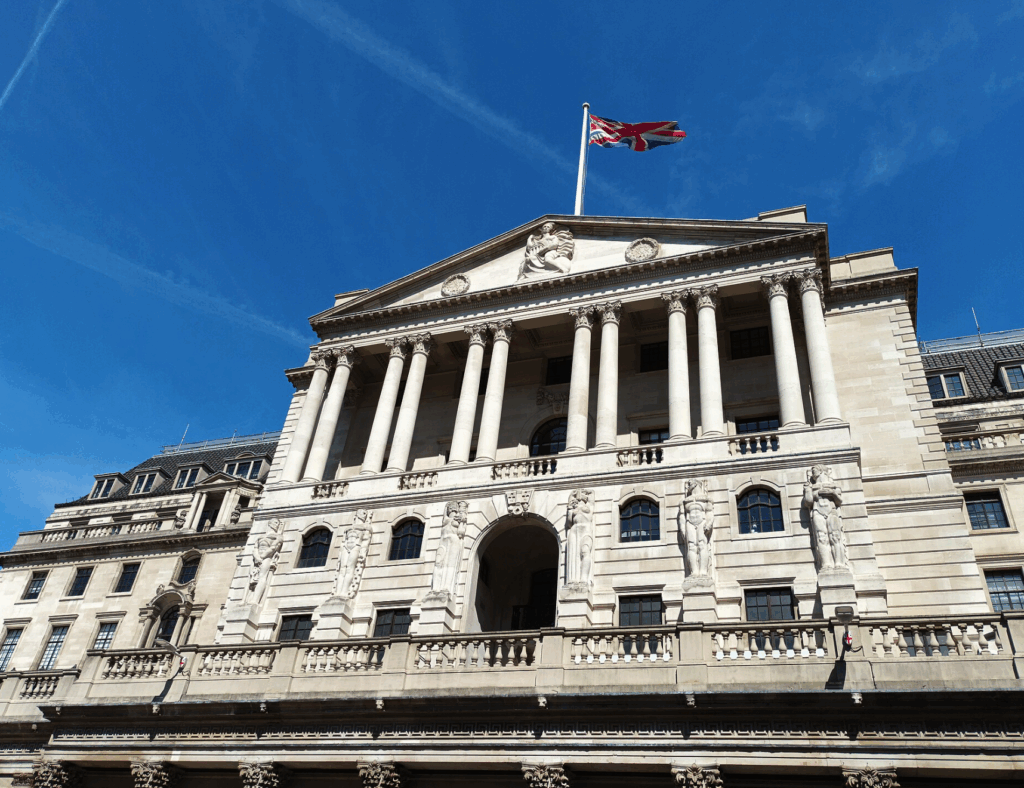Key Points
- Research suggests the Bank of England (BoE) is cautious about further rate cuts after lowering the rate to 4.25% on May 8, 2025.
- It seems likely that policymakers need more evidence of sustained inflation decline, given high wage growth (5.9%) and services inflation (4.7%).
- The evidence leans toward U.S. tariffs impacting UK growth and inflation, with a recent UK-US trade deal lowering some tariffs but keeping others at 10%.
- There’s debate on the pace of future rate cuts, with markets expecting no cuts before September and only 50 basis points by year-end.

Background
The BoE recently cut interest rates by 25 basis points, bringing the benchmark rate to 4.25%. This decision, made on May 8, 2025, was supported by a split vote, with 5 members favoring the cut, 2 advocating for a larger 50 basis point cut, and 2 preferring no change. Policymakers, including Deputy Governor Clare Lombardelli and external member Megan Greene, have expressed caution, emphasizing the need for more data showing inflation sustainably returning to the 2% target.
Trade and Economic Context
A recent UK-US trade deal, announced on the same day, lowered British tariffs on U.S. goods from 5.1% to 1.8% for items like cars and steel, but maintains a 10% tariff on most British exports to the U.S. This deal aims to support UK industries but doesn’t fully resolve trade tensions, potentially affecting economic growth and inflation.
Market Reactions
Following the rate cut and trade deal, investors have reduced expectations for further BoE rate cuts, now anticipating no action before September 2025 and a total of 50 basis points by year-end. The pound has shown mixed movements, holding steady against the dollar and rising 0.59% against the euro, with the FTSE 100 index up 0.59%.
Investigation Report: Bank of England’s Cautious Stance on Further Rate Cuts and UK-US Trade Dynamics
The Bank of England (BoE) has recently signaled a cautious approach to further interest rate cuts following its decision on May 8, 2025, to lower the benchmark rate by 25 basis points to 4.25%. This move, supported by a split vote within the Monetary Policy Committee (MPC), reflects ongoing concerns about inflation and economic growth, particularly in light of U.S. tariff policies and a new UK-US trade agreement. This report provides a detailed analysis, drawing on recent statements from key policymakers, economic data, and market reactions.
Background and Context
On May 8, 2025, the BoE’s MPC voted 5-2-2 to cut the Bank Rate from 4.5% to 4.25%, marking the first rate reduction since February 2025
Policymakers, including Deputy Governor Clare Lombardelli and external MPC member Megan Greene, have emphasized the need for more evidence of sustained inflation decline. Lombardelli, speaking at the Bank of England Bank Watchers’ Conference on May 12, 2025, stated that wages are still growing too fast for inflation to sustainably reach the 2% target, with wage growth at 5.9% for the three months to February 2025
BoE’s Monetary Policy Stance
The BoE’s cautious approach is rooted in balancing inflation control with economic growth support. Lombardelli supported the recent rate cut but described current monetary policy as still restrictive, emphasizing the dual goal of “suppressing inflation” while “avoiding excessive suppression of economic demand”
Recent economic indicators support this caution. While headline inflation has fallen, services inflation remains above pre-pandemic averages, and wage growth, though down from peaks, is still significantly above levels consistent with 2% inflation. The BoE’s next rate decision is scheduled for June 19, 2025, with markets expecting no further cuts before September and only 50 basis points by year-end
Impact of U.S. Tariff Policies and UK-US Trade Agreement
The timing of the BoE’s rate decision coincides with significant trade developments, particularly the UK-US trade agreement announced on May 8, 2025. This deal, hailed as historic by both President Trump and UK Prime Minister Keir Starmer, lowers British tariffs on U.S. goods from 5.1% to 1.8%, specifically targeting cars, steel, and aluminum, while maintaining a 10% tariff on most British exports to the U.S.
Lombardelli and Greene both acknowledged the potential impact of U.S. tariffs on the UK economy. Lombardelli warned that global growth could be “knocked” by Trump’s tariff plans, which might suppress inflation in the short term but could lead to higher costs and lower productivity if global trade fragments
Economic Data and Market Reactions
Recent economic data underscores the BoE’s caution. Headline inflation fell to 3.2% in March 2025, but services inflation at 4.7% indicates persistent core price pressures
Market reactions to the BoE’s decision and the trade deal have been mixed. Investors have reduced expectations for further rate cuts, now anticipating no action before September 2025 and only 50 basis points by year-end, reflecting concerns about inflation persistence
Long-Term Outlook and Risks
The BoE’s cautious stance is also influenced by long-term risks, particularly the potential for global trade fragmentation. If U.S. tariffs lead to retaliatory measures and a more divided trade system, this could drag on UK economic output and productivity, potentially exacerbating inflation pressures
Lombardelli and Greene’s statements suggest the BoE is monitoring these developments closely, balancing the need for monetary easing with the risk of reigniting inflation.
In summary, the BoE’s cautious approach to further rate cuts reflects ongoing concerns about inflation, particularly in services and wages, amid a complex global trade environment shaped by U.S. tariffs and the recent UK-US trade deal. Market expectations and economic data suggest a slow path to further easing, with significant uncertainties ahead.



+ There are no comments
Add yours